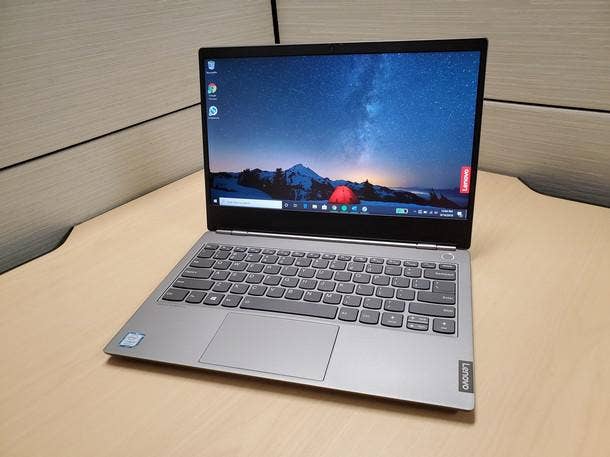Review: Lenovo's ThinkBook Offers Appealing Design And Features For The Money
The CRN Test Center found that the affordably priced notebook for SMBs makes good use of the ThinkPad heritage, while introducing a metallic chassis and useful new capabilities.

With its new ThinkBook portfolio of laptops, Lenovo has achieved a rare feat: offering a laptop priced well under $1,000 that is highly usable for the majority of day-to-day business needs.
And it looks pretty nice, too.
[Related: Partners: Lenovo ThinkBook Has A Winning Formula For SMBs]
At the CRN Test Center, we've been trying out the 13-inch model of the new notebook line, the ThinkBook 13s, which Lenovo is just now starting to roll out. The ThinkBook 13s and its 14-inch counterpart, the ThinkBook 14s, are aimed at meeting the laptop needs of small and midsize businesses, while also bringing an improved look and feel over most other entry-level notebooks.
We think Lenovo has succeeded at its goal--with the ThinkBook 13s delivering on the promise of offering much of the functionality you'll find in a ThinkPad, but with significantly lower pricing and a millennial-friendly design. While our 256 GB tryout model of the ThinkBook 13s is priced at just $713, the notebook does not at all seem cheap. (The notebooks are kept affordable in part thanks to measures such leaving out full enterprise-class capabilities around security and manageability, in favor of standard business capabilities.)
Our tryout unit came configured with an eighth-gen Intel "Whiskey Lake" processor, the Core i5-8265U, and 8 GB of RAM. Performance was solid. While multi-tasking across multiple apps and browser windows, we didn't notice any of the hiccups one might expect from an inexpensive notebook. A Geekbench 4 benchmark test revealed respectable results, with a single-core score of 3,940 and a multi-core score of 10,176.
While battery life is not necessarily touted as one of the biggest selling points of the ThinkBook 13s—it features a fairly modest-sized 45Whr battery--we were pleasantly surprised to get 6.5 hours of battery life on a charge. Our results came from a "real world" test of heavy usage of multiple apps, with the brightness set to 75 percent. By comparison, the ThinkPad X390, which was priced $450 higher for our tryout model, yielded only an hour more than that on battery life.
Speaking of brightness, one highlight of the ThinkBook 13s is that the display goes up to 300 nits of brightness, which is on par with many more-expensive business notebooks on the market. The display itself features FHD resolution and looks good overall. Again, it's better than one might expect for a $700 laptop.
The bezels on the top, left and right sides of the display are slim, though the bottom bezel is fairly sizable, which does detract a bit from the look.
However, the thin bezels on the left and right sides of the screen help to keep the notebook to a compact size overall. We found the ThinkBook 13s to be extremely portable, with a weight of just under 3 pounds and a thickness of 0.63 of an inch.
Of course, the real standout element of the ThinkBook is the all-aluminum "mineral gray" chassis, which parts ways with the black carbon-fiber body of the standard ThinkPad. It's a savvy move by Lenovo to bring an aluminum chassis to its SMB line, with the ThinkBook offering a much sleeker appearance than the average ThinkPad. It helps to prove, as Lenovo executives have been saying, that the company is upping its focus on SMB and not treating this part of the market as a second-class citizen.
Notably, the ThinkBook also continues the ThinkPad's tradition of durability. The ThinkBook meets durability standards such as the ability to withstand extreme temperatures and includes other features as well such as a spill-resistant keyboard.
Business users will also appreciate that the ThinkBook is generous on ports, with the notebook offering a USB-C port, two UBS-A ports and HDMI.
The keyboard is another strong point. The keys are comfortable and offer good key travel, reflecting the ThinkPad heritage of excellent keyboards. The touchpad is also highly responsive.
Another sign that Lenovo is doubling down on SMB with the ThinkBook is the inclusion of several special features with the notebook, which we found to be worthwhile additions.
The most helpful feature is the that the power button doubles as a fingerprint reader on the ThinkBook. This allows users to boot up and log in with a single press. We found the feature to work flawlessly when powering up the ThinkBook. We're glad to see Lenovo paying attention to the little things like this that can add up to creating a better computing experience on the whole.
We also tried out the ThinkBook feature that lets you listen to music while the laptop is in standby mode. This worked well, too, and it's definitely a nice thing to have considering the notebook's battery life.
Other ThinkBook features that should be interesting to business users include hot keys that are enabled for answering or hanging up Skype calls, along with enhanced security via an integrated webcam cover and Trusted Platform Module encryption.
Ultimately, we believe the ThinkBook should connect nicely with its target SMB audience. It's speedy, its hardware is far from cheap-feeling, and its look is much more consumer-like than one can get in ThinkPads or other SMB-focused laptops.
All in all, the ThinkBook seems a strong value for the money and a great option for many SMBs to consider.